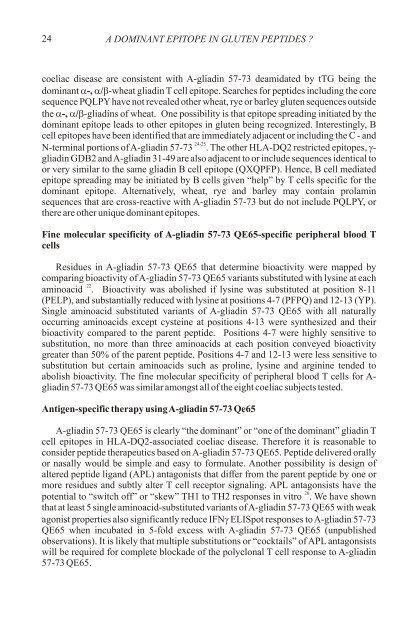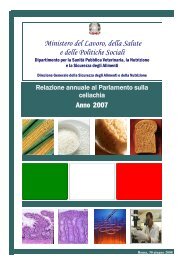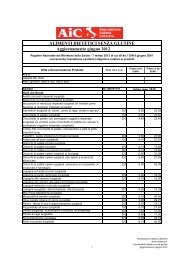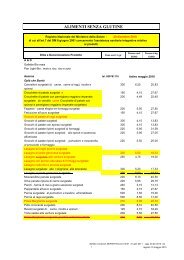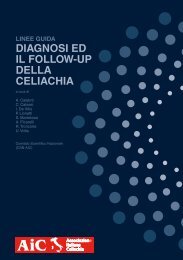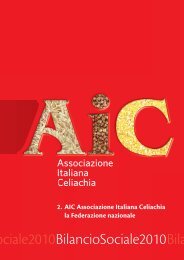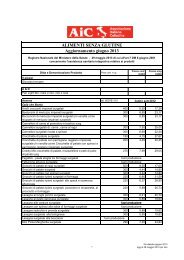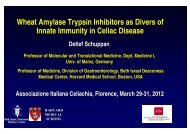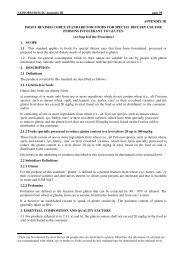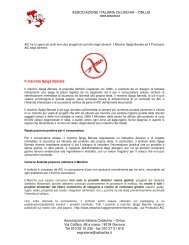primary prevention of coeliac disease - Associazione Italiana ...
primary prevention of coeliac disease - Associazione Italiana ...
primary prevention of coeliac disease - Associazione Italiana ...
You also want an ePaper? Increase the reach of your titles
YUMPU automatically turns print PDFs into web optimized ePapers that Google loves.
24 A DOMINANT EPITOPE IN GLUTEN PEPTIDES ?<br />
<strong>coeliac</strong> <strong>disease</strong> are consistent with A-gliadin 57-73 deamidated by tTG being the<br />
dominant a-, a/b-wheat gliadin T cell epitope. Searches for peptides including the core<br />
sequence PQLPY have not revealed other wheat, rye or barley gluten sequences outside<br />
the a-, a/b-gliadins <strong>of</strong> wheat. One possibility is that epitope spreading initiated by the<br />
dominant epitope leads to other epitopes in gluten being recognized. Interestingly, B<br />
cell epitopes have been identified that are immediately adjacent or including the C - and<br />
24-25<br />
N-terminal portions <strong>of</strong> A-gliadin 57-73 . The other HLA-DQ2 restricted epitopes, g-<br />
gliadin GDB2 and A-gliadin 31-49 are also adjacent to or include sequences identical to<br />
or very similar to the same gliadin B cell epitope (QXQPFP). Hence, B cell mediated<br />
epitope spreading may be initiated by B cells given “help” by T cells specific for the<br />
dominant epitope. Alternatively, wheat, rye and barley may contain prolamin<br />
sequences that are cross-reactive with A-gliadin 57-73 but do not include PQLPY, or<br />
there are other unique dominant epitopes.<br />
Fine molecular specificity <strong>of</strong> A-gliadin 57-73 QE65-specific peripheral blood T<br />
cells<br />
Residues in A-gliadin 57-73 QE65 that determine bioactivity were mapped by<br />
comparing bioactivity <strong>of</strong> A-gliadin 57-73 QE65 variants substituted with lysine at each<br />
22<br />
aminoacid . Bioactivity was abolished if lysine was substituted at position 8-11<br />
(PELP), and substantially reduced with lysine at positions 4-7 (PFPQ) and 12-13 (YP).<br />
Single aminoacid substituted variants <strong>of</strong> A-gliadin 57-73 QE65 with all naturally<br />
occurring aminoacids except cysteine at positions 4-13 were synthesized and their<br />
bioactivity compared to the parent peptide. Positions 4-7 were highly sensitive to<br />
substitution, no more than three aminoacids at each position conveyed bioactivity<br />
greater than 50% <strong>of</strong> the parent peptide. Positions 4-7 and 12-13 were less sensitive to<br />
substitution but certain aminoacids such as proline, lysine and arginine tended to<br />
abolish bioactivity. The fine molecular specificity <strong>of</strong> peripheral blood T cells for A-<br />
gliadin 57-73 QE65 was similar amongst all <strong>of</strong> the eight <strong>coeliac</strong> subjects tested.<br />
Antigen-specific therapy using A-gliadin 57-73 Qe65<br />
A-gliadin 57-73 QE65 is clearly “the dominant” or “one <strong>of</strong> the dominant” gliadin T<br />
cell epitopes in HLA-DQ2-associated <strong>coeliac</strong> <strong>disease</strong>. Therefore it is reasonable to<br />
consider peptide therapeutics based on A-gliadin 57-73 QE65. Peptide delivered orally<br />
or nasally would be simple and easy to formulate. Another possibility is design <strong>of</strong><br />
altered peptide ligand (APL) antagonists that differ from the parent peptide by one or<br />
more residues and subtly alter T cell receptor signaling. APL antagonsists have the<br />
26<br />
potential to “switch <strong>of</strong>f” or “skew” TH1 to TH2 responses in vitro . We have shown<br />
that at least 5 single aminoacid-substituted variants <strong>of</strong> A-gliadin 57-73 QE65 with weak<br />
agonist properties also significantly reduce IFNgELISpot responses to A-gliadin 57-73<br />
QE65 when incubated in 5-fold excess with A-gliadin 57-73 QE65 (unpublished<br />
observations). It is likely that multiple substitutions or “cocktails” <strong>of</strong> APL antagonsists<br />
will be required for complete blockade <strong>of</strong> the polyclonal T cell response to A-gliadin<br />
57-73 QE65.


